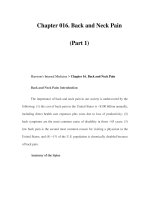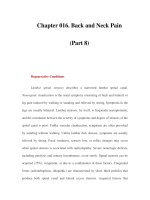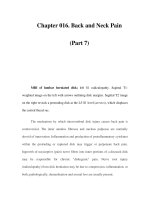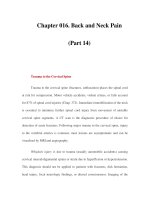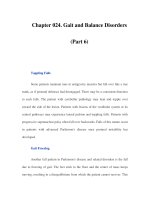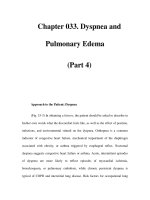Chapter 130. Streptococcal and Enterococcal Infections (Part 8) ppsx
Bạn đang xem bản rút gọn của tài liệu. Xem và tải ngay bản đầy đủ của tài liệu tại đây (51.92 KB, 6 trang )
Chapter 130. Streptococcal and
Enterococcal Infections
(Part 8)
Deep Soft-Tissue Infections: Treatment
Once necrotizing fasciitis is suspected, early surgical exploration is both
diagnostically and therapeutically indicated. Surgery reveals necrosis and
inflammatory fluid tracking along the fascial planes above and between muscle
groups, without involvement of the muscles themselves. The process usually
extends beyond the area of clinical involvement, and extensive debridement is
required. Drainage and debridement are central to the management of necrotizing
fasciitis; antibiotic treatment is a useful adjunct (Table 130-3), but surgery is life-
saving.
Treatment for streptococcal myositis consists of surgical drainage—usually
by an open procedure that permits evaluation of the extent of infection and ensures
adequate debridement of involved tissues—and high-dose penicillin (Table 130-
3).
Pneumonia and Empyema
GAS is an occasional cause of pneumonia, generally in previously healthy
individuals. The onset of symptoms may be abrupt or gradual. Pleuritic chest pain,
fever, chills, and dyspnea are the characteristic manifestations. Cough is usually
present but may not be prominent. Approximately one-half of patients with GAS
pneumonia have an accompanying pleural effusion. In contrast to the sterile
parapneumonic effusions typical of pneumococcal pneumonia, those complicating
streptococcal pneumonia are almost always infected. The empyema fluid is
usually visible by chest radiography on initial presentation, and its volume may
increase rapidly. These pleural collections should be drained early, as they tend to
become loculated rapidly, resulting in a chronic fibrotic reaction that may require
thoracotomy for removal.
Bacteremia, Puerperal Sepsis, and Streptococcal Toxic Shock
Syndrome
GAS bacteremia is usually associated with an identifiable local infection.
Bacteremia occurs rarely with otherwise uncomplicated pharyngitis, occasionally
with cellulitis or pneumonia, and relatively frequently with necrotizing fasciitis.
Bacteremia without an identified source raises the possibility of endocarditis, an
occult abscess, or osteomyelitis. A variety of focal infections may arise
secondarily from streptococcal bacteremia, including endocarditis, meningitis,
septic arthritis, osteomyelitis, peritonitis, and visceral abscesses.
GAS is occasionally implicated in infectious complications of childbirth,
usually endometritis and associated bacteremia. In the preantibiotic era, puerperal
sepsis was commonly caused by GAS; currently, it is more often caused by GBS.
Several nosocomial outbreaks of puerperal GAS infection have been traced to an
asymptomatic carrier, usually someone present at delivery. The site of carriage
may be the skin, throat, anus, or vagina.
Beginning in the late 1980s, several reports described patients with GAS
infections associated with shock and multisystem organ failure. This syndrome
was called the streptococcal toxic shock syndrome (TSS) because it shares certain
features with staphylococcal TSS. In 1993, a case definition for streptococcal TSS
was formulated (Table 130-4). The general features of the illness include fever,
hypotension, renal impairment, and respiratory distress syndrome. Various types
of rash have been described, but rash usually does not develop. Laboratory
abnormalities include a marked shift to the left in the white blood cell differential,
with many immature granulocytes; hypocalcemia; hypoalbuminemia; and
thrombocytopenia, which usually becomes more pronounced on the second or
third day of illness. In contrast to patients with staphylococcal TSS, the majority
with streptococcal TSS are bacteremic. The most common associated infection is a
soft tissue infection—necrotizing fasciitis, myositis, or cellulitis—although a
variety of other associated local infections have been described, including
pneumonia, peritonitis, osteomyelitis, and myometritis. Streptococcal TSS is
associated with a mortality rate of ≥30%, with most deaths secondary to shock and
respiratory failure. Because of its rapidly progressive and lethal course, early
recognition of the syndrome is essential. Patients should receive aggressive
supportive care (fluid resuscitation, pressors, and mechanical ventilation) in
addition to antimicrobial therapy and, in cases associated with necrotizing fasciitis,
surgical debridement. Exactly why certain patients develop this fulminant
syndrome is not known. Early studies of the streptococcal strains isolated from
these patients demonstrated a strong association with the production of pyrogenic
exotoxin A. This association has been inconsistent in subsequent case series.
Pyrogenic exotoxin A and several other streptococcal exotoxins act as
superantigens to trigger release of inflammatory cytokines from T lymphocytes.
Fever, shock, and organ dysfunction in streptococcal TSS may reflect, in part, the
systemic effects of superantigen-mediated cytokine release.
Table 130-
4 Proposed Case Definition for the Streptococcal Toxic
Shock Syndrome
a
I. Isolation of group A streptococci (Streptococcus pyogenes)
A. From a normally sterile site
B. From a nonsterile site
II. Clinical signs of severity
A. Hypotension and
B. ≥2 of the following signs
1. Renal impairment
2. Coagulopathy
3. Liver function impairment
4. Adult respiratory distress syndrome
5. A generalized erythematous macular rash that may desquamate
6. Soft tissue necrosis, including necrotizing fasciitis or myositis; or
gangrene
a
An illness fulfilling criteria IA, IIA, and IIB is defined as a definite
case.
An illness fulfilling criteria IB, IIA, and IIB is defined as a probable
case if no
other etiology for the illness is identified.
Source:
Modified from Working Group on Severe Streptococcal Infections:
JAMA 269:390, 1993.
